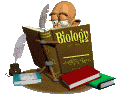Chapter
Objectives
- Define tissue and explain
where it falls in the hierarchy of structural organization
- From micrographs or
diagrams, correctly identify the following animal tissues,
explain how their structure relates to function, and give
examples of each
- epithelial: cuboidal,
columnar, squamous
- connective: adipose,
cartilage, bone
- muscle: skeletal
(striated), cardiac, smooth
- nervous
- Describe how metabolic
rate can be determined for animals and distinguish between
basal metabolic rate and standard metabolic rate
- Describe several body
shapes that maximize external surface area in contact with
the environment
- Explain how animals
with complex internal organization and relatively small surface
area to volume ratio can have adequate surface area for materials
exchange with the environment
- Describe the location
and function of interstitial fluid
- Define homeostasis
- Distinguish between
negative and positive feedback
|

